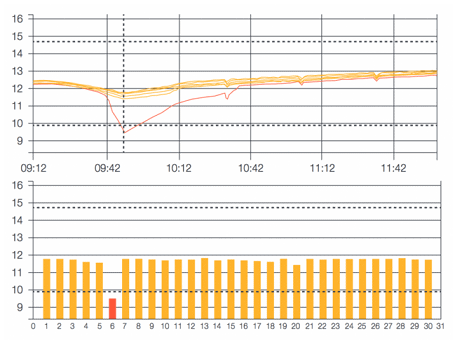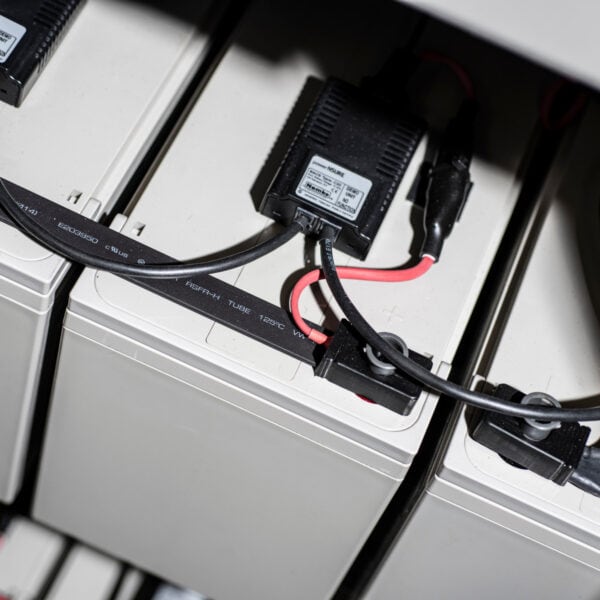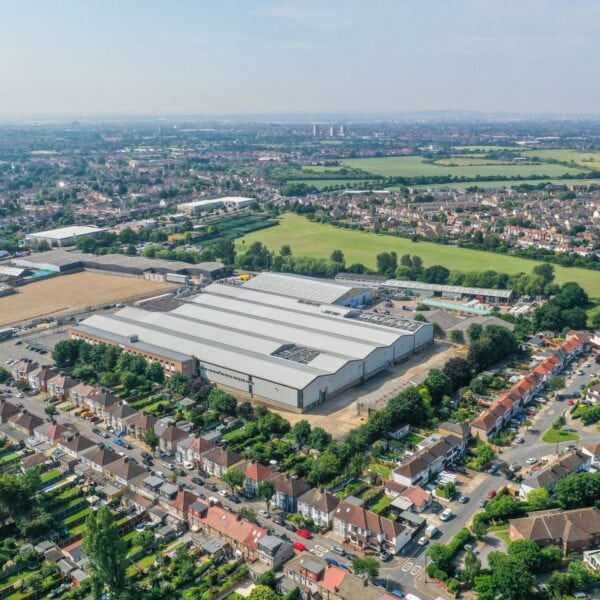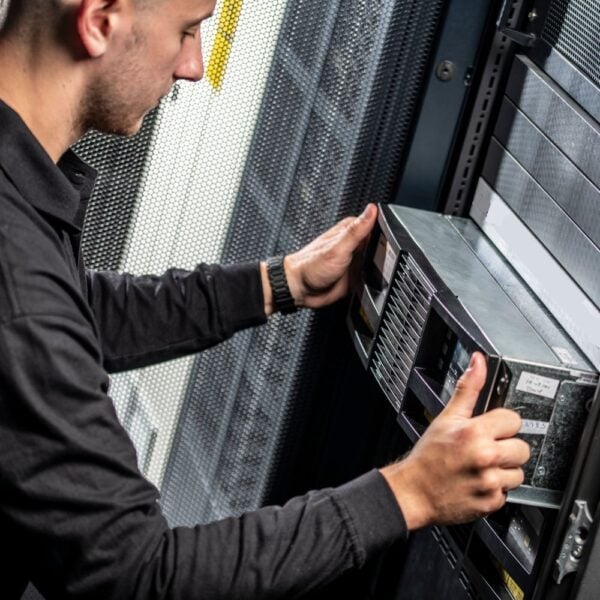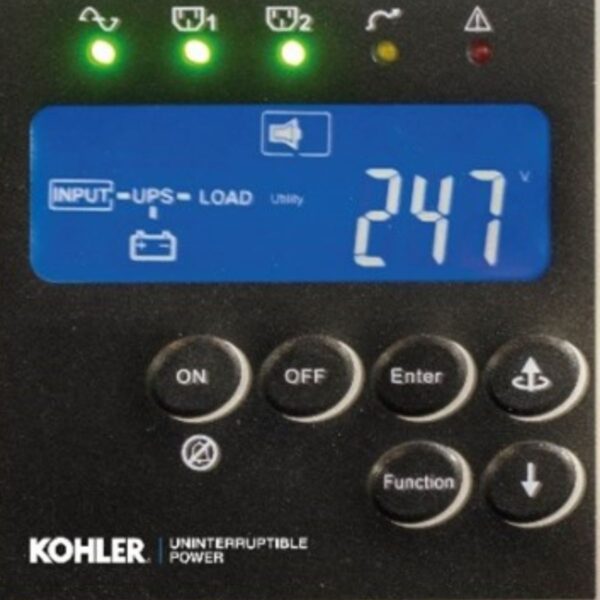Emergency lighting is an essential safety requirement for any building. In this article, Alan Luscombe, director at KOHLER Uninterruptible Power Ltd., a KOHLER company, shows how a well-designed, correctly specified and properly maintained battery backup system can ensure that the lights come on when they need to.
In some circumstances, the presence of emergency lights that operate reliably when called upon, and provide sufficient illumination along all escape routes, may make the difference between safe evacuation and panic, injury or possibly even death. Accordingly, emergency lighting is an essential part of any building services installation, and subject to extensive British and European legislation.
Emergency lighting, by definition, depends on a continuously-charged battery backup power source. The lighting can detect a mains power failure and switch to battery backup automatically and immediately. The battery power source must be well-designed, well-maintained, always fully-charged and ready for use, and very highly reliable. In this article we look at how to achieve such a battery implementation; we start with a summary of emergency lighting requirements and legislation, together with types of luminaires used within these schemes. We then consider how a battery power source can be designed and maintained to ensure it performs as described above.
Emergency lighting installations
The Industry Committee for Emergency Lighting (ICEL) has published an Emergency Lighting Design Guide, intended to give engineers a wider understanding of the different types of emergency lighting and their correct application. The Guide references the British and European standard BS EN 1838, which specifies the luminous requirements for emergency escape lighting and standby lighting systems installed in premises or locations where such systems are required. It is principally applicable to locations where the public or workers have access. The overall objective of emergency escape lighting is to enable safe exit from a location in the event of failure of the normal supply.
The Guide shows specific forms of emergency lighting, as shown in Fig.1 below:
Fig.1: Forms of emergency lighting as defined by ICEL
The emergency escape lighting allows safe exit if the normal power supply fails and forms part of a building’s fire protection system. Escape route lighting allows safe exit from buildings by illuminating escape routes, and ensures that firefighting and safety equipment can be readily located and used. Open area or anti-panic area lighting reduces the likelihood that people panic while enabling safe movement of occupants towards escape routes. High risk task area lighting ensures the safety of people involved in a potentially dangerous process or situation, and allows proper shutdown procedures to be completed for the safety of other occupants; for example, protecting people from dangerous machinery.
Standby lighting allows normal activities to continue after the normal mains supply has failed. This lighting does not provide fire protection unless it meets the same equipment, design and installation requirements as emergency escape lighting systems.
The major legislative standards that apply to emergency lighting systems include The Construction Products Directive (89/106), The Workplace Directive (89/654) and The Signs Directive (90/664). Other UK legislative requirements exist for certain premises, such as theatres and cinemas.
The Construction Products Directive specifies that prompt lighting is provided automatically and for a suitable time in a specific area when the normal power supply to the lighting fails. The lighting must comply with BS 5266-1. BS EN 50171 also applies. The Signs Directive states that signs requiring some form of power must be provided with a guaranteed supply.
Three-hour duration is generally required for emergency lighting, although one-hour duration may be acceptable in some premises if evacuation is immediate and re-occupation is delayed until the system has recharged. To conserve power, light output may be reduced, often down to 10% of normal light output.
Emergency light fittings are either maintained or non-maintained. Maintained types operate together with other lights in the area during normal supply; however they also continue to operate, although at a lower level, during a power failure. Non-maintained fittings are normally switched off, only powering up from battery when the mains fails. They are not part of the general lighting scheme and usually comprise emergency exit signs and other such fittings.
Static inverters for emergency lighting
KUP is well-known as a supplier of both UPS systems for data centres, and static inverters for centralised emergency lighting applications. These products share some attributes. Above all, whether they’re supporting a mission-critical data centre or an emergency lighting system, they must offer very high availability and readiness for instant action when it counts.
They both make use of the same key components – rectifier, batteries and inverter – and both deploy these components in various configurations according to their applications’ priorities. In fact, UPS systems would support emergency lighting perfectly well, but with considerable oversizing. Inverters such as KUP’s KOHLER EL range include single-phase and three-phase solutions from 500 VA to 160kVA and are designed specifically for emergency lighting and similar applications.
These inverters can work in different modes – passive, active or no-break standby – to suit the emergency lighting type. For incandescent or fluorescent lights, a passive standby mode is sufficient. Power is delivered directly from the mains to the lights during normal operation, but if the mains fails the load is automatically transferred to the output of the inverter, which is powered by the battery. As the inverter’s components are de-energised during normal operation, energy is saved, component life is maximised through reduced stress, hence less maintenance is required.
However, if high pressure discharge lamps are being used, a No-Break static inverter becomes a better solution. This is because the lighting load is always fed from the inverter, with no switchover delay during a power failure. Avoiding a power interruption prevents the restrike delay of possibly up to one or two minutes that occurs with many high pressure discharge lamps. These inverters can also be used with incandescent and fluorescent lights; in all cases flicker is eliminated and lamp life extended as the lighting system is constantly fed with stabilised, smoothed and conditioned power.
Active standby offers a variant on No-Break mode, in which the inverter is constantly running but off-load. This reduces stress on the inverter, improving its reliability and risk of failing when the lighting load is switched in during a mains blackout.
The KOHLER EL inverters comply with the latest European EN 50171 specification for emergency lighting, and all can support a 120% continuous overload as demanded by the standard. The products power up with a ‘soft start’ to limit inrush current and prevent overloading of marginally-rated mains supplies. For more capacity or higher availability, multiple inverters can be paralleled in hot standby, redundant or symmetric parallel mode.
The EL inverters are easy to install, with front access for fast maintenance. Different models with various options are available, including ingress protection ratings to IP41 and ambient operating temperatures to 40°C. High efficiencies to 97% or better at 100% load minimise operating costs. Remote monitoring and communications is supported with both dry contacts and RS232 serial communications.
The inverters feature an LCD display which provides accurate, detailed information about loads, batteries and inverter with advanced diagnostics. Some models include intelligent battery monitoring to maximise service life.
While the EL inverters are designed to meet the demands of emergency lighting systems with high availability, they need regular inspection, service and maintenance to underwrite their ability to do so. Most if not all emergency lighting inverter owners will set up an ongoing preventative maintenance and emergency callout contract with their inverter supplier or possibly a third party.
As the heart of any EL inverter, and its most vulnerable component, the battery should receive particular attention; however, capacitors, fans, contactors and other components should also be regularly checked and replaced as part of the preventative maintenance schedule.
As stated above, legislation calls for three hours’ battery backup during a power failure; this is a long duration, and calls for a significant number of batteries backed by a robust battery care regime to ensure reliable operation if the power fails. Accordingly, KUP is seeing a trend towards adoption of their PowerNSURE dedicated battery monitoring, management and care system.
Using remote access via the Web, PowerNSURE checks the internal resistance, temperature and voltage of every battery sequentially. It then uses an equalisation process to correct charging voltages and obtain a balanced charging condition across every battery in the string. This eliminates gassing, dry-out and thermal runaway, and prevents battery undercharging. The constant monitoring and controlling of the individual charging voltages for each battery guarantees the availability of the battery at all times. Early indication of problems allows suspect batteries to be replaced before they compromise the inverter’s backup capability.
Fig.2: PowerNSURE battery performance graph
Fig.2 shows an example of a failing battery. It shows how battery 6 is underperforming after 30 minutes of discharge into a 45-minute run. By using this warning to replace the battery immediately, the lifetime of the complete battery system is extended without risk to the load.
Conclusions
Under ideal circumstances, a building’s emergency lighting will never be needed. However, facilities managers cannot control the quality or availability of their site’s incoming utility power, so a battery system that delivers effective emergency lighting without interruption if the mains does fail is essential. This protects the building’s occupants from harm, allows orderly shutdown of dangerous equipment, and ensures compliance with building and equipment safety regulations.
This article has been published in the June 2017 edition of Mission Critical Power magazine


